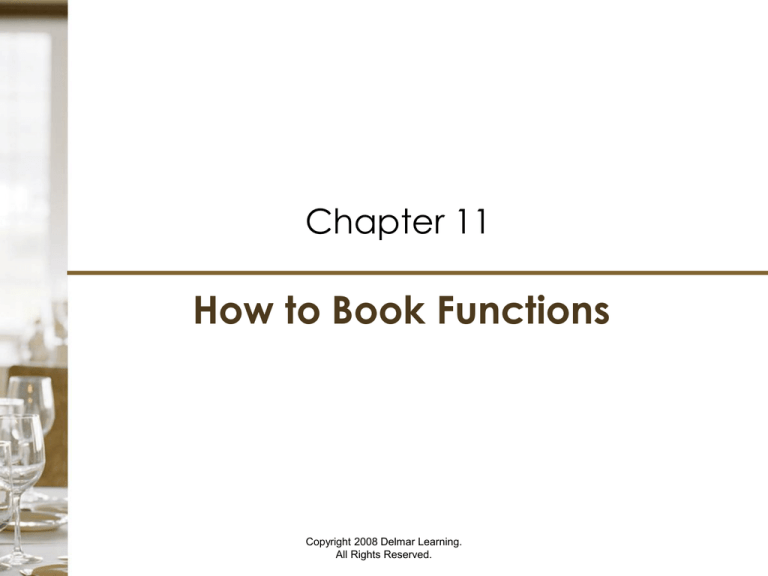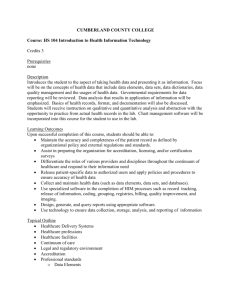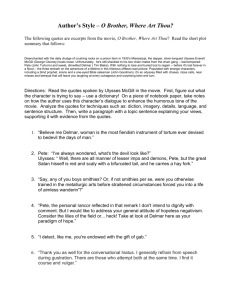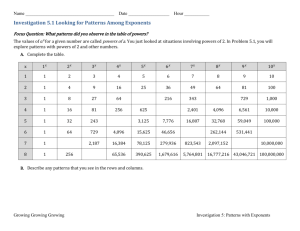
Chapter 11
How to Book Functions
Copyright 2008 Delmar Learning.
All Rights Reserved.
What Is a Function?
• Any use of a banquet facility
•Room rented by client
– May use at no charge
•Examples
–
–
–
–
Copyright 2008 Delmar Learning.
All Rights Reserved.
What Is a Function? (continued)
•Clients deal directly with the banquet
office
– The banquet manager
– A catering and sales manager
– Group sales office
• Depending on the size of the establishment
Copyright 2008 Delmar Learning.
All Rights Reserved.
What Is a Function? (continued)
•Once an event is booked, the
responsibility for the event’s success
belongs to the BANQUET MANAGER
• Successful functions begin with proper
booking of the event
Copyright 2008 Delmar Learning.
All Rights Reserved.
What Must Be Known about
Function Room Setups
•Regardless of the type of function, the
person booking the function MUST
KNOW SPECIFIC FACTS about the
INDIVIDUAL BANQUET FACILITY
•First needed fact is the number of
rooms available and capacity for
either meal or meeting functions
Copyright 2008 Delmar Learning.
All Rights Reserved.
What Must Be Known about
Function Room Setups (continued)
•Second needed fact is the type of physical
setups that will accommodate guests
COMFORTABLY and EFFICIENTLY
•Third needed fact is equipment availability
– Whether it has been assigned to another
function
• How, where, and at what cost to obtain extra
equipment
Copyright 2008 Delmar Learning.
All Rights Reserved.
What Must Be Known about
Function Room Setups (continued)
•Finally—the manager will have to be
able to perform the job WITHOUT
having to ask any QUESTIONS about
the room layout
Copyright 2008 Delmar Learning.
All Rights Reserved.
Room Availability and Capacity
•Function room—space calculated so
that guests receive generally 8 to 12
square feet of space per person for a
sit-down (plated) meal
•Formula is mathematically accepted,
but the projected number of guests
WILL NOT FIT INTO THE ROOM
Copyright 2008 Delmar Learning.
All Rights Reserved.
Room Availability and Capacity
(continued)
• Experienced banquet managers know
that each function is an individual
party that may require different
demands on the room, resulting in a
different capacity for the room
Copyright 2008 Delmar Learning.
All Rights Reserved.
Room Availability and Capacity
(continued)
•Factors such as
– Location of exits, shape of the head table
– The traffic flow and dance floor
– The audiovisual equipment, type of function
must be taken into consideration before the
realistic capacity of a room for each
function can be determined
•“Moment of truth” occurs when the guests
sit down and have enough room
Copyright 2008 Delmar Learning.
All Rights Reserved.
Types of Room Setups for Functions
•Guests DO NOT want to
– Be too crowded into a room
• Fails that “moment of truth”
– Be in too big a room with extra space
• Makes the event appear to be a failure
•Banquet managers must know how to
use room space effectively in order to
maximize revenue
Copyright 2008 Delmar Learning.
All Rights Reserved.
Types of Room Setups for Functions
(continued)
•
– Social events use round tables
• Weddings or dinners
– Encourages conversation
– Business events use
• Block tables
• T-shaped tables or e-shaped tables
– Eliminates unnecessary conservation
– See Figure 11-1, Figure 11-2, and Figure
11-3
Copyright 2008 Delmar Learning.
All Rights Reserved.
Types of Room Setups for Functions
(continued)
•Meeting setups—generally two types
– Theater style
•
• Guests provided only chairs, ALL facing the
same direction
– Used when attending a presentation
Copyright 2008 Delmar Learning.
All Rights Reserved.
Types of Room Setups for Functions
(continued)
•Meeting setups—generally two types
– Schoolroom or classroom
• All guests facing toward the front of the room
while seated at the tables for note taking
purposes
• Used for teaching a seminar
• Uses the most amount of space, which lessens
the amount of guests
Copyright 2008 Delmar Learning.
All Rights Reserved.
Types of Room Setups for Functions
(continued)
•
– Place in front of the room
• Guests seated only on one side of the table,
facing the other members of the party
– A trend at social events
• A round table as the head table, placed in
the middle of the party, allows hosts of the
party to enjoy themselves more
Copyright 2008 Delmar Learning.
All Rights Reserved.
Types of Room Setups for Functions
(continued)
•
– Flow of guests is important
– Be creative in using space
• Lobbies or pools of hotels
– Position of food and beverage is important
• Guest comfort and ease of service
• Minimize traffic jams
– Setup relatively easy
• Only has a few tables to deal with
Copyright 2008 Delmar Learning.
All Rights Reserved.
Types of Room Setups for Functions
(continued)
•Cocktail parties
– Should be fewer chairs than guests
• Forces the guest to socialize
– A room can accommodate more guests
than a sit-down (plated) dinner because
less chairs are needed
Copyright 2008 Delmar Learning.
All Rights Reserved.
Types of Room Setups for Functions
(continued)
•Once the banquet manager and the client
determine the number of guests and type of
setup desired, the manager can decide on
which room accommodates the group
comfortably and efficiently
•Manager must draw a diagram for the room
setup to be correct BUT needs to know what
equipment is available for setting up rooms
Copyright 2008 Delmar Learning.
All Rights Reserved.
Available Equipment
•The manager knows the capacity of
ALL the rooms and the types of
functions that may be booked into
each room
•The manager next needs to know the
types and sizes of tables available so
that the function is planned with
comfort for the guests and efficiency
for the banquet establishment
Copyright 2008 Delmar Learning.
All Rights Reserved.
Available Equipment (continued)
•See Figure 11-5—types of tables
• Round ables create jovial atmosphere,
encouraging conversation
– Come in two general sizes:
• 60 inches in diameter
– Seats 8 guests
• 72 inches in diameter
– Seats 10 guests
Copyright 2008 Delmar Learning.
All Rights Reserved.
Available Equipment (continued)
•Round tables
– Take up more space than rectangular
tables
– Cannot seat as many guests as with
rectangular tables
Copyright 2008 Delmar Learning.
All Rights Reserved.
Available Equipment (continued)
• Oblong or rectangular tables
– Three basic sizes:
• 30 inches wide by 96 inches long
– An 8-foot table
• 18 inches wide by 96 inches long
– 8-foot by 1½ feet or skinny
• 30 inches wide by 72 inches long
– A 6-foot table
• See Figure 11-6
Copyright 2008 Delmar Learning.
All Rights Reserved.
Available Equipment (continued)
•Oblong or rectangular tables
– Guests require 24 inches of linear space to
be comfortable
– An 8-footer will seat 8 people —4 on each
side
– A 6-footer will seat 6 people —3 on each
side
Copyright 2008 Delmar Learning.
All Rights Reserved.
Available Equipment (continued)
•Space between tables
– When seated back-to-back
• With rectangular tables
– 60 inches is recommended between tables
• With round tables
– 54 inches is recommended between tables
– Experiment with the room
• Set up the room to determine space between
tables
Copyright 2008 Delmar Learning.
All Rights Reserved.
Available Equipment (continued)
• Special-shaped tables
– Trapezoid, serpentine, quarter- and halfround tables are best used for setting up
food or bar stations or to create
interestingly shaped buffet lines rather
than for the guests’ dining
Copyright 2008 Delmar Learning.
All Rights Reserved.
Available Equipment (continued)
•
– Placed in the center of the head table
• Takes up 24 inches of space
– Place for notes of the speaker
– Light and microphone
• Podium—same purpose as a lectern
– Takes up 24 inches of space
– Difference is that podium is FREESTANDING
Copyright 2008 Delmar Learning.
All Rights Reserved.
Available Equipment (continued)
• Microphones—manager must know
–
–
–
–
–
Different types of microphones
Where power source is
How to turn system on
How to adjust the volume
How to eliminate annoying feedback
•Common mistakes made with microphones
– Adjusting the volume not loud enough
– Setting microphone too far away from speaker’s
mouth
Copyright 2008 Delmar Learning.
All Rights Reserved.
Available Equipment (continued)
• Audiovisual equipment
– Manager must know
• How to operate it
• Where to rent equipment not owned
– How much to charge the client for the rental
– Larger facilities have their own AV department
• Price sheet for all equipment is available
• Employs staff to set up and operate equipment for an
hourly fee
Copyright 2008 Delmar Learning.
All Rights Reserved.
Things to Keep in Mind
•Planning the correct setup of a function is an
integral part of the success or failure of a
business meeting or party
•Use common sense when booking rooms
– Don’t put a wedding reception next to a
business meeting that ONLY has a pullout wall as
a divider
• WILL NOT ABSORB SOUND AS PROMISED
Copyright 2008 Delmar Learning.
All Rights Reserved.
Things to Keep in Mind (continued)
• ALL equipment MUST BE in the room
and thoroughly tested before guests
arrive
•If equipment is rented, know how to
operate it
•If owned, schedule regular
maintenance
Copyright 2008 Delmar Learning.
All Rights Reserved.
A Final Point about Room Setups
•Rule of thumb
– Function rooms are large enough to
accommodate all guests comfortably
– Exception to the rule:
• Press conferences are planned for a small
room to give the impression that the event
was an overwhelming success
Copyright 2008 Delmar Learning.
All Rights Reserved.
Physically Setting Up the
Function Rooms
•Banquet manager should NOT set up
the function rooms
•Banquet manager should draw a
diagram of the room simply and
concisely for the setup people to use
and follow
– Check the room after setup to make sure
the diagram was followed
– See Figure 11-7
Copyright 2008 Delmar Learning.
All Rights Reserved.
Physically Setting Up the
Function Rooms (continued)
•Two final tips:
– Diagram should be on 8½-X-11-inch
paper, able to be carried around
– Whenever feasible, suggest the same
physical setup to the next client
• Will cut down on labor costs
• Will increase setup crew’s morale
Copyright 2008 Delmar Learning.
All Rights Reserved.
Booking Functions
•Once the capacity and the use of the
function room is known, the next task is to
book functions
•Booking is done by a sales, catering, or
banquet manager who knows
– Exactly what types of
– Accommodations for meetings
– Charges for services establishment offers clients
Copyright 2008 Delmar Learning.
All Rights Reserved.
Booking Functions (continued)
•Banquet managers work from
– Set-priced menus
•Caterers set prices on factors:
–
–
–
– How much demand for
Copyright 2008 Delmar Learning.
All Rights Reserved.
Function Book
•An organized system to keep bookings
straight
– Lists ALL rooms the establishment has to
rent on a daily basis
• See Figure 11-8
•Today being replaced with computer
software
– Advantage: Backup copies of all
bookings can be saved and/or printed
Copyright 2008 Delmar Learning.
All Rights Reserved.
Function Book (continued)
• Does NOT provide information about
the menu or the party
•Only provides
– Who reserved the room
– Whether it is a firm or tentative booking
– Approximate time and number of guests
•Main purpose is to avoid overbooking
Copyright 2008 Delmar Learning.
All Rights Reserved.
Function Book (continued)
•Care and storage of the book
– Such an integral part of the establishment
• Kept in a permanent place in the office
– Locked away when nobody is in the office
• Only authorized people make entries
– In pencil
– Identify themselves by placing their initials in the
entry
Copyright 2008 Delmar Learning.
All Rights Reserved.
Qualifying Business
•Need a policy to determine the
amount of money that must be made
when a room is booked
•Once determined, the manager should
attempt to book parties that will bring
in the most revenue
Copyright 2008 Delmar Learning.
All Rights Reserved.
Qualifying Business (continued)
•Qualifying a client means to determine
– How much money the client will spend at
the establishment
– Whether the client can pay for the party
•Once the business is qualified, a date
can be entered into the function book
as a tentative or firm booking
Copyright 2008 Delmar Learning.
All Rights Reserved.
How Far in Advance May
Banquets Be Booked?
•Determined by each banquet facility
– Develop a schedule that fits your business
based upon demand for space
•Client agrees to pay a set amount,
regardless if 1 person or 100 people
attend
Copyright 2008 Delmar Learning.
All Rights Reserved.
Difference between Tentative
and Firm
• Firm booking
– Easiest to understand
– Client gives a deposit for a party
• Establishment enters into the function book
– The amount and date of deposit
– The word “Firm”
– Your
Copyright 2008 Delmar Learning.
All Rights Reserved.
Difference between Tentative
and Firm (continued)
• Tentative booking
– Enter client’s name into function book
– Client will have first refusal
– May be held for a week without a deposit
• After a week, if still interested, deposit is
required
•Problems with tentative booking
– Some dates are more popular than others
Copyright 2008 Delmar Learning.
All Rights Reserved.
Deposits
•Required for almost ALL banquet
events
•Protect both parties
– Banquet house will not sell the date to
another client that wants the same date
– Client will not cancel the event without
losing the money they have put down for
the event
Copyright 2008 Delmar Learning.
All Rights Reserved.
Deposits (continued)
• Refunds of deposits
– Each banquet house must have its own
policies
• No refund policy
• Refund if canceled within a certain time frame
• Refund if another group books that date
– Keep in mind what would be in
• The best interest of the guest
• The best interest of the business
Copyright 2008 Delmar Learning.
All Rights Reserved.
Guarantees
•A promise made by the host of the
party that a certain number of guests
will attend
– Host pays for the number promised,
UNLESS more guests attend
– Host will pay on the higher guest count
•A guarantee is usually required three to
four days before the event
Copyright 2008 Delmar Learning.
All Rights Reserved.
Guarantees (continued)
•Establishments usually set up for 5
percent above the guarantee
– Helps forecast if more guests show up
– May charge 10 percent menu premium if
guest count is beyond 5 percent of
guarantee
•Key to managing successful banquets:
Communication on informing guests of
ALL policies when event is booked
Copyright 2008 Delmar Learning.
All Rights Reserved.
Room Rentals
•Different ways to charge for room
rentals
– Food and beverage package
• In addition to room rental
– Just meeting room is used
• No food and beverages offered
– Book a certain number of hotel rooms
• The meeting room(s) are included
Copyright 2008 Delmar Learning.
All Rights Reserved.







